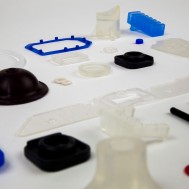The type of o-ring used in a given application depends on the surface it comes in contact with. The surface can either be dynamic, meaning in motion, or static, meaning without movement. If there is no movement between the mating surfaces, static seals are used. Conversely, if there is movement between two mating surfaces, dynamic seals should be applied.
Depending on the direction of compression, static seals can be broken down into two types: axial or radial seals. Dynamic seals are also broken down into different types depending on the type of motion. These seals include reciprocating, rotary and oscillating.
Aside from the basic differences between these two types of seals, there are other major differences that have an impact on seal design. Here’s a closer looks at what sets these seals apart.
1. Material Selection Will Differ
Since dynamic seals are constantly in motion, the rubber material needs to be stronger and more resistant to wear than static seals. Friction is a common cause for abrasion and general wear over time. Materials such as nitrile that offer high abrasion or high temperature resistance should be applied in dynamic applications. Lower squeeze will help lower friction for o-rings that are less resistant. However, lower squeeze can lead to potential leaks in low pressure conditions.
2. Dynamic Seals Require More Maintenance
Static seals are installed in a motionless environment. This allows static seals to last over an extended period of time, especially when the right material is selected that can withstand the application conditions. Factors such as temperature, pressure and chemical exposure have a large impact on the lifespan of a seal.
Since dynamic seals are exposed to movement and friction, their lifespan is ultimately shorter than static seals. Dynamic seals will require more maintenance and at a faster rate compared to static seals. It’s important to keep this in mind in order to avoid seal failure.
3. Pay Attention to Gland Design
To minimize the potential premature wear of dynamic seals, the material of the gland should not abrade the o-ring when the application is in motion. The surface finish of both the gland and the o-ring should be compatible to avoid tears and seal failure. A highly polished surface is not desirable for dynamic seals because it will not retain the necessary lubrication.
While both static and dynamic seals require lubrication to function properly, dynamic seals require more lubrication to withstand friction over time.
Want to learn more about static and dynamic seals?
Contact an engineer today.
